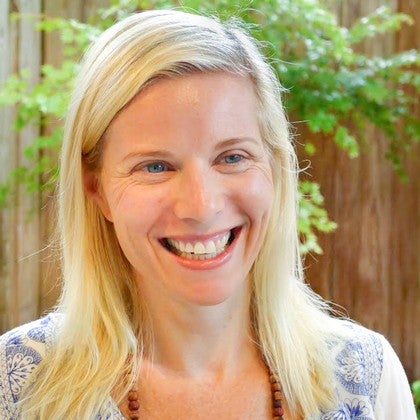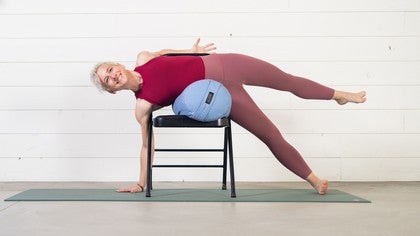
Balance: Use It or Lose It
Holding tree pose was a stalwart skill I relied on (and possibly flaunted) in every yoga class I took. With one foot lifted and pressed against my opposite inner thigh, my face always remained relaxed: eyes soft and mind sure. I never fell out of a dancer pose in those sweaty rooms of my Bikram yoga days. The first time I stepped on a standup paddle board, I barely wobbled. My balance seemed unshakeable.
The fact that I could always rely on my balance meant a great deal to me. I hadn’t been an athletic youth in the conventional sense. Perhaps I couldn’t run fast or dribble, but I could balance.
Until I couldn’t.
A few years ago, I was testing-out to become a certified natural movement instructor and failed the balance portion of the physical exam right out of the gate. I fell off the 2x4 board so quickly that I was actually entitled to request a do-over -- but I didn’t because I was mystified by my fall. What was that? My one super-hero talent had suddenly vanished. Poof!
Balance is funny that way; we don’t seem to appreciate it until we lose it.
But how do we lose our sense of steadiness? Many of us might answer with one simple word: age. We tend to correlate a decrease in balance with an increase in age. But is this true? And when we lose our sense of balance, where does it go?
Katy Bowman says in her book, Dynamic Aging, that “age isn’t solely responsible for a dramatic loss of balance — the problem is more a sedentary lifestyle where [we] haven’t practiced balance in a long time.” She adds that “the moves we do with confidence are simply the moves we do multiple times a day.”
I find this comforting. The balance of our youth is not something to be lost but something to be maintained.
Ever heard of the vestibular system? It’s the miracle inside your head that assures your stability.
As a sensory network, the vestibular system is basically three structures of your inner ear that resemble loops and act as canals filled with fluid and tiny hair follicles to help detect movement. These ducts are called semicircular canals and each of the three loops detects a different movement of the head: up-down, left-right, or tilting side-to-side. These intricate canals of your inner ear allow for proper balance and spatial orientation.
For those whose eyes are glazing over, let’s circle back to a more practical take on the vestibular system: the three canals that make up the gyroscope of your inner ear prevail over your health. This is because the homeostasis of your physical system depends on your ability to feel stable. Mobility and balance go hand-in-hand.
Since mobility and balance stay vital in partnership, Steve Maxwell, a former jiu-jitsu champion turned strength & conditioning coach, reminds us that the partnership between your balance and your mobility is a two-way street. The quality of your vestibular system enables the quality of your movement; but it is also true that the quality of your movement generates the quality of your vestibular system.
If your movement is not healthy, this can have debilitating effects on your vestibular system. Essentially, unhealthy movement - or, more commonly, lack of movement - can lead to an unhealthy vestibular system. Maintaining movement is key to maintaining balance. Move or lose it has never rung so true.
In Christopher McDougall’s interview with Steve Maxwell for Outside Magazine, McDougall sums up Maxwell’s take on the importance of a healthy vestibular system through healthy movement by saying, “Stiffening isn’t just another part of aging, it’s a death sentence…We’re creatures of mobility, so when we give up our ability to move, we’re signaling to our body that it is time to shut down.”
Maxwell warns in the interview that just because you work-out on a regular basis, you are still most likely spending more time sitting (or standing) in a day than you are moving. This is a problem because the vestibular system will adapt to your sedentary lifestyle. As you get lazy, so does your vestibular system.
The body is efficient. If you are not using an attribute of your physical system on a regular basis, the body will eventually assume that you don’t need this attribute and it will discontinue efforts to keep this attribute well-tuned. Your physical system is not going to waste precious efforts on maintaining something you don’t seem to care about.
This has a snowball effect: the less you move, the less likely you are to feel confident when you move. When you lose your confidence in moving, you will move even less. The cycle continues until mobility becomes something so limited that it is to be feared.
And you can’t be afraid to move! Movement is your life force.
There is a great article by MovNat Founder, Erwan LeCorre, that lists 8 Natural Movements for Better Balance. In the article, Erwan reminds us that balance is simple, but not necessarily easy. He urges us to “never confuse simple with easy.” This way, we won’t do what I did and dismiss balance as something so simple that we take it for granted. Keep in mind, balancing is not easy and must be practiced like any other physical skill.
One of the most practical pieces of advice I have received from numerous sources in regards to maintaining balance is simple: take care of your feet.
Your feet are the foundation of your balance. With all their sensory nerve endings reporting information back to the brain, the feet are extraordinary instruments of perception in your physical system – like antennae or the tongue of a snake. Don’t cut off these vessels of perception by constricting them in stiff, confining shoes. Make the healthy leap of investing in minimal shoes and better yet (and far less expensive), go barefoot and let your feet stretch and feel the earth.
Roll the sole of your foot on a tennis ball (or a golf ball, if you’re feeling brave). Stretch your calves (the tendons of your feet extend up into your lower leg). Stand on pebbles. Walk on a beach and dig your feet into sand. Find a place in your yard or garden where you can sink your feet into the soil and probe the earth with your toes.
My husband and I have a 2x4 on our back porch that we walk across as often as possible. When we first laid the 2x4 down, our daughter was only two years old and she stunningly walked across the board at a skill level already comparable to ours - even though walking in general was a relatively new skill for her.
We are born with robust vestibular systems. We just need to stay inspired to keep them that way.
Harken the days of your childhood when practicing balance was a daily pleasure. Stand on one leg while you brush your teeth or rise up onto the balls of your feet while you’re pumping gas and see if you can hold this position with arms relaxed at your sides for a few breaths. Let balance become as common in your day as eating - because it is equally as important.
Comments
You need to be a subscriber to post a comment.
Please Log In or Create an Account to start your free trial.













